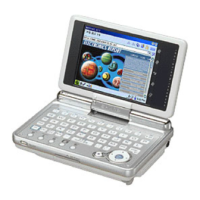
Do you have a question about the Sharp SL-C1000 and is the answer not in the manual?
| RAM | 64 MB |
|---|---|
| Flash ROM | 128 MB |
| Display Type | TFT LCD |
| Connectivity | USB, IrDA |
| Battery | Lithium-ion rechargeable |
| Operating System | Linux |
| Display Resolution | 640 x 480 pixels |
| Input Method | Touchscreen |
| Expansion Slots | SD Card |
Brief overview of the Zaurus as a mobile Linux device and initial setup steps.
Detailed comparison of SL-C1000, SL-C3000/C3100, and other SL-C models across key attributes.
Highlights essential distinctions like battery, harddrive capacity, and USB port functionality.
Lists all items included in the Zaurus package for verification upon arrival.
Step-by-step guide for inserting the battery and initiating the charging process.
Instructions on how to open, turn, and position the display safely to avoid damage.
Identifies and describes the ports and controls located on the bottom of the Zaurus.
Identifies and describes ports on the back, including the function of the Serviceport.
Instructions for resetting the device using the hidden button in the battery compartment.
Explains the use of the scrollwheel and OK/Cancel buttons for single-handed operation.
Details the English keyboard layout and how to use the Fn key for special functions.
Explains the remapping of Japanese keys to Ctrl/Alt using the KeyHelper applet.
Describes the dedicated keys for quick access to frequently used applications.
Explains the roles of OK, Cancel, and the cursor ring for navigation and confirmation.
How to input special characters via key combinations and the KeyHelper applet.
Instructions for taking screenshots and where the image files are stored.
Information regarding the compatibility of SL-5500(G) applications on SL-C Zauris.
Essential steps for installing drivers to enable Zaurus recognition by Windows.
Guide to installing IntelliSync software for synchronizing data with a PC.
Provides alternative steps for installing IntelliSync if the primary method fails.
Explains file sharing via Windows Neighborhood and Telnet access for configuration.
Details the Zaurus's USB port's ability to act as both host and client.
Instructions on how to access the Zaurus storage as a USB drive for file transfer.
Step-by-step guide for manually mounting USB memory devices when the Zaurus acts as a host.
Instructions for connecting and utilizing a USB keyboard with the Zaurus.
Information on the built-in Movie Player and Personal Information Management applications.
Procedure to revert the device to its original Japanese configuration after a factory reset.
Detailed steps to enter the flash menu for performing system resets.
Explanation of the four main options available in the Japanese flash menu for system management.
Details the initial boot screens, logos, and the necessary steps for calibrating the touch display.
Instructions for restoring a backup from a memory card, including website links for downloads.
Guide to selecting the correct tab, source, and backup set within the utility.
Steps for confirming and executing the backup restore, and final system restart.
Addresses issues with addressbook sorting and suggests using alternative PIM applications.
Notes on the limited functionality of the Network Wizard outside of Japan.
Introduction to OpenZaurus as an alternative OS, including installation considerations for specific models.
Lists Zaurus model nicknames used to identify compatible OpenZaurus versions.
Lists the essential files needed for installing OpenZaurus onto the device.
Instructions on how to return the device to the original SHARP ROM from OpenZaurus.
Detailed procedure for entering the device's diagnostic mode using key combinations.
Explains how to move through menu options and select functions using the stylus.
Procedures for safely exiting the service mode and rebooting the device.
Step-by-step guide for creating a complete 1:1 backup of the Zaurus's NAND memory.
How to access and select options for NAND and HDD backup/restore in the service menu.
Detailed instructions for restoring a system backup file, emphasizing correct usage.
Steps to boot the Zaurus into a command-line interface for emergency recovery purposes.
Details regarding the non-removable harddrive and necessary service procedures.
Compilation of official websites, community forums, and software indexes for further assistance.
Lists official SHARP accessories designed to enhance Zaurus functionality.
Lists compatible accessories from third-party manufacturers.
Information regarding the device's compliance with various European EMV and safety directives.
Details FCC compliance, potential interference issues, and user warnings for the device in the USA.